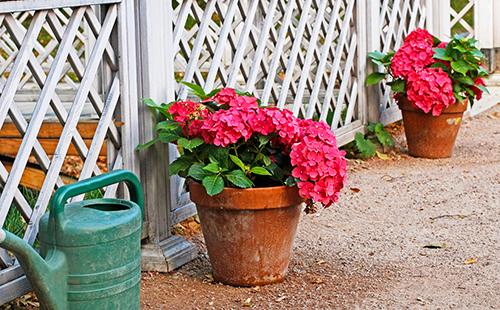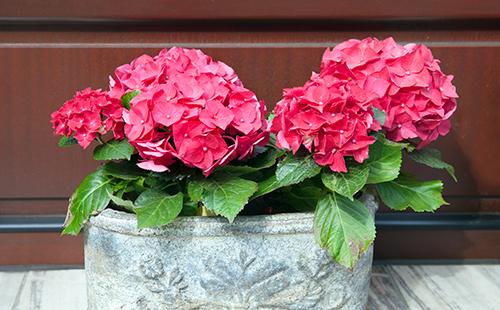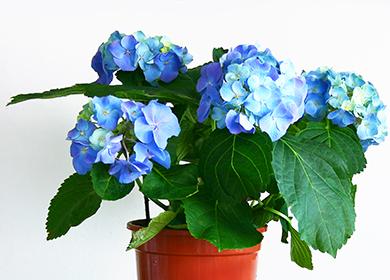The content of the article
Beautiful flowering perennial shrub is common in garden and indoor culture. Combines relative unpretentiousness in leaving and high decorativeness. The botanical name for room hydrangea is hydrangea, but in the people it has been dubbed "eastern beauty" and "pretty deceiver."
Description and interesting features
Hydrangea forms a multi-stem bush. The leaves are large, saturated color, beautiful shape. Hydrangea flowers of two types are large barren and small fruit-bearing. Inflorescences are dense, spherical, of different colors. Varieties with white, pink, lilac, lettuce flowers are common. Petals are almost colorless, sepals give them decorativeness. On one bush, up to seven magnificent inflorescences bloom simultaneously. In rare cases, indoor hydrangea is extended to a meter. More often the height of the bush does not exceed half a meter. Colors are usually more saturated than in garden varieties.
Popular varieties
Despite the variety of hydrangea varieties, not all of them are suitable for growing in indoor pots. Most of the varieties are used as garden shrubs. In apartments, most often contains large-leaf hydrangea. A little less - panicle and tree-like. There are several more species, but they are rarely grown in pots. The most common are four varieties.
- Panicle. In nature, grows in the form of a large shrub. Shoots quickly lignified. The buds begin to form back in June, fully bloom only at the end of summer or the beginning of autumn. Pyramidal inflorescences are interesting by a change in shade during flowering.
- Tree-like. Large shrub with woody shoots. Freshly blossomed flowers have a greenish color, gradually becoming white or cream.
- Dubolistnaya. It differs from other varieties by unusual beautiful leaves. It blooms profusely and continuously. During flowering, the hue changes from white to purple.
- Large leaf. Differs in dense leaves of bright green color. Umbrella inflorescences, like viburnum. The colors are different. Many hybrid varieties are bred.
Room hydrangea care and microclimate parameters
Knowing how to care for room hydrangea, you can achieve long-term flowering of the "eastern beauty". The main requirement is the creation of a favorable microclimate for growth, compliance with the conditions of detention in the winter. To achieve stable growth and regular flowering, it is recommended to follow a number of rules.
- Lighting. Choose a well-lit place, protected from direct sunlight. Grows and fully blooms in light partial shade.
- Temperature. Hydrangea does not like heat - prefers a coolness of 18–20 ° С. Suitable average room temperature, subject to regular ventilation of the room. In winter, the temperature is lowered to 8-10 ° C, with the onset of spring, it is again raised.
- Watering. Watering hydrangea should be plentiful - she loves moisture. Regular bathing is beneficial - the flower is completely immersed in water, then left to drain water. Do not bathe during flowering. It is watered only with soft rain, thawed or boiled water. In winter, adhere to a more moderate watering regime, until the first buds appear.
- Humidity. With high humidity, it looks better. You need regular, year-round spraying. In hot weather and when kept near radiators, they spray more often than usual.
- The soil. For hydrangea, acidic soil with a pH of 5.5 is used. The optimal substrate is a mixture of peat and coniferous land, with the addition of coarse sand, humus.
- Top dressing. Fertilizer is often applied - every week. They feed less in winter than in summer. Choose any balanced mineral fertilizer for flowering home crops. The dosage is observed according to the instructions.
- Transfer. Until the age of three, the bush is transplanted each spring into a larger pot. As they grow older, hydrangea begins to grow more slowly, the need for transplants decreases. It is enough to transplant an adult bush once every three years to replace depleted soil with more nutritious.
Trimming and hydrangia formation
The pruning frequency depends on the plant growth rate. The faster the bush develops, the more often it has to be cut. Hydrangea inflorescences are formed at the very tops of the shoots, so they can not be cut. To obtain a lush branched bush, formation begins early - immediately after rooting and the beginning of growth. The exception is the repairing varieties of hydrangeas - they can be cut at any time.
If hydrangea gives too many shoots, the bush needs to be thinned out. Excess shoots are cut off, sometimes together with flowers. Cropped tops can be used as planting stock for propagation. After flowering, wilted inflorescences are pruned above the highest bud.
Two days before pruning, hydrangea is not watered. In order to form and maintain decorativeness, old, weak, diseased shoots are cut. Use a sharp sterile secateurs or scissors. Slices smeared with brilliant green. Watering resumes only after drying the slices. A full-fledged, regularly flowering bush has no more than eight branched trunks.
Breeding methods
Hydrangea gradually grows old, begins to bloom weaker, loses decorativeness - this is inevitable and natural. About once every four years, young plants are grown to replace the old bush. Home hydrangea can be propagated by seeds, dividing the bush and cuttings.
Cuttings
The most favorable period for cuttings is from mid to late winter. Cuttings are cut with a margin - the roots are not formed at all. Cuttings are carried out in three stages.
- As cuttings, root shoots up to 7 cm long are used. Each cuttings should have three internodes.
- Slices are treated with a root stimulant - “Heteroauxin” or “Kornevin.” Cuttings are planted in wet peat mixed with sand.
- Shanks are covered with polyethylene or glasses to obtain a greenhouse effect. Until signs of growth appear, a stable humidity of 80% and a temperature of about 20 ° C are maintained. The greenhouse is periodically ventilated, the soil is moistened with a spray bottle.
Bush division
Hydrangea is shared in spring, simultaneously with transplantation. You can share at other times - before or after flowering. The division is carried out in five steps.
- The day before the procedure, hydrangea is watered - it is easier to free the roots from moist soil.
- The bush is carefully removed from the pot, shake off excess soil.
- Inspect the root system - dried, diseased roots are cut off.
- The bush is cut into several parts depending on its size. For division use a sharp sterile knife.
- Delenki planted in separate pots, slightly moisten the soil, put in a shaded, cool place for better adaptation.
Sowing seeds
You can use store-bought or hand-picked seeds. In the case of hybrid varieties, a discrepancy in the appearance of the mother plant and the seedling is possible. The best time for sowing is autumn. Act in four stages.
- As a substrate, a mixture of sheet soil, peat and sand is used. Fill the container with a substrate, moisturize it. Seeds are sown without pre-soaking, sprinkled with a thin layer of the same soil.
- The container is covered with film or glass. After a day, the shelter is removed, the greenhouse is aired, the soil is moistened. Maintain a stable temperature of 14-20 ° C.
- Shoots appear on average after a month and a half. Sometimes a little earlier, if germination conditions are precisely observed, there are no temperature fluctuations. The film is immediately removed, the container is rearranged in a well-lit place.
- At the stage of two or three true leaves, seedlings can be planted in separate pots.

Growing problems
Hydrangea is sensitive to violation of the conditions of detention. Insufficient or excessive watering, prolonged lack of top dressing, and inappropriate temperature conditions lead to a decrease in decorativeness. To understand what a plant lacks is possible by its appearance. The table summarizes the main problems that gardeners have to deal with.
Table - Hydrangea Growing Problems
| Appearance | Probable cause | Solution to the problem |
|---|---|---|
| Hydrangea wilts, looks stunted | - excess moisture; - poor drainage; - the appearance of pests | - The plant is transplanted, the roots are checked; - dried, rotten roots are cut off; - treated with the drug "Fitosporin" or any other fungicide; - reduce watering by several days |
| Leaves turn uneven, veins remain green | - Lack of iron (chlorosis) | - The plant is transplanted with a complete replacement of the soil; - sprayed with a drug with iron chelate (vitriol with the addition of citric acid) |
| Leaves dry around the edges | - Lack of moisture in soil or air | - Regularly watered hydrangea; - sprayed daily |
| The shoots dry and break | - drying of roots | - Hydrangea abundantly watered; - dried shoots cut off; - further maintain stable soil moisture |
| Light or white spots appear on the leaves | - Sunburn | - The leaves spoiling decorativeness are cut; - the flower pot is rearranged in a slightly shaded place |
| Flower grows slowly | - Lack of nutrients; - too close a pot | - Transplanted into a more spacious pot, the soil is completely replaced; - if the pot is not small, make balanced mineral fertilizer |
Typical pests
Hydrangea is often affected by pests. The likelihood of insects increases when kept in dry air, with poor drainage, or with irregular watering. As a preventive measure, the proximity to the affected plants is excluded, the soil is sterilized before planting. Signs of hydrangea damage by pests and ways to combat them can be seen in the table.
Table - Hydrangea Pests
| Insect name | External signs | Methods of struggle |
|---|---|---|
| Spider mite | - The upper side of the leaves becomes reddish; - light dots and thin web appear | - Increase air humidity; - sprayed with “Aktara”, for a day they throw polyethylene on a bush to maintain high humidity |
| Aphid | - Young shoots are twisted, deformed; - stems and leaves are covered with a sticky coating; - often a soot fungus joins the aphid lesion | - The leaves of the plant are gently wiped with a sponge dipped in soapy water; - sprayed with a drug containing permethrin or tobacco dust (infusion) |
| Stem nematode | - On the shoots of hydrangea, brown spots with bark are formed; - the flowers turn green, are deformed; - central leaf veins thicken; - the plant stops growing | - Destroy the plant (it is impossible to get rid of the stem nematode) |
| Mealybug | - Leaves and stems are covered with a whitish waxy coating; - white “cotton” lumps are formed, mainly in the axils of the leaves | - The plant is sprayed with mineral oil (wash off with soapy water in a day); - treated with any insecticide |
| Thrips | - Pollen is showered from hydrangea flowers; - holes appear on the petals; - silver stripes first appear on the leaves, then the entire surface acquires a silver hue - with the naked eye you can notice small black insects | - Spend repeated treatment with any insecticide |

Common diseases
Most often, hydrangea is affected by fungal diseases. They are provoked by excessive dampness of the soil, high humidity combined with low temperature. After the defeat, pests have to deal with bacterial diseases. Many insects are their carriers. A description of the most common hydrangea diseases and methods for their treatment can be found in the table.
Table - Hydrangea Diseases
| The name and cause of the disease | External manifestations | Method of treatment |
|---|---|---|
| Gray rot (fungus) | - The plant fades, becomes covered with a gray velvety coating | - Affected leaves and stems pruned; - treated with Bordeaux liquid or any fungicide |
| Powdery mildew (fungus) - sometimes mistakenly called powdery mildew | - Leaves are covered with uneven powdery coating, dry and fall off | - Wash the plant with a solution of green soap; - cut off strongly affected shoots; - repeatedly sprayed with fungicide |
| Black leg (fungus) | - The trunk blackens and rots at ground level | - Cut the cuttings from healthy branches to replace the plants; - the plant is transplanted, diseased shoots are cut to a healthy tissue completely; - treated with a fungicide or a solution of the drug "Metronidazole" |
| Viral infection (virus spread by pests) | - Circular or multi-colored spots appear on the leaves; - leaves are deformed, dry out | - Take measures to control pests; - severely affected shoots are cut; - for two months, at ten-day intervals, the flower is treated with a mixture of Fitolavin, Epin, ExtraFlor and boric acid preparations |
Growing room hydrangea at home is an interesting and not very difficult task. For your efforts, the plant will reward you with magnificent flowering. Hydrangea is planted as an independent plant; in the composition, it is used only in open ground.

